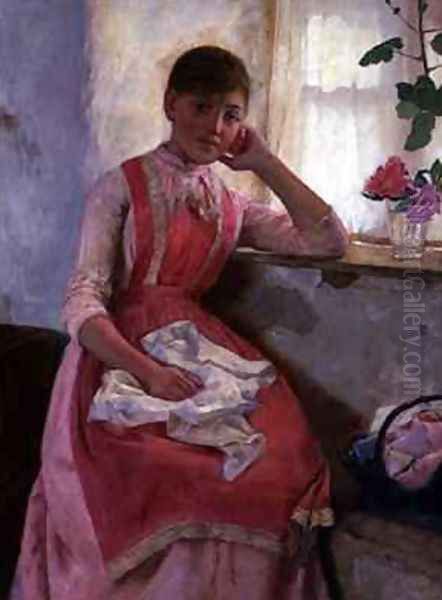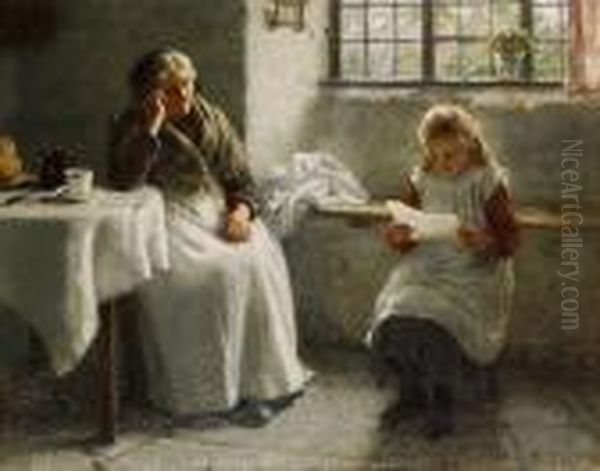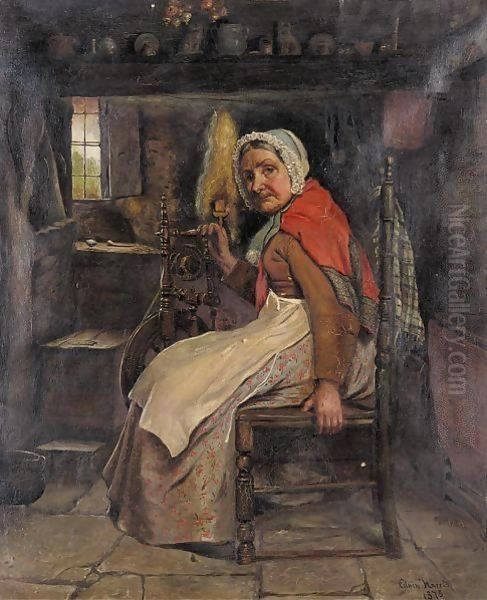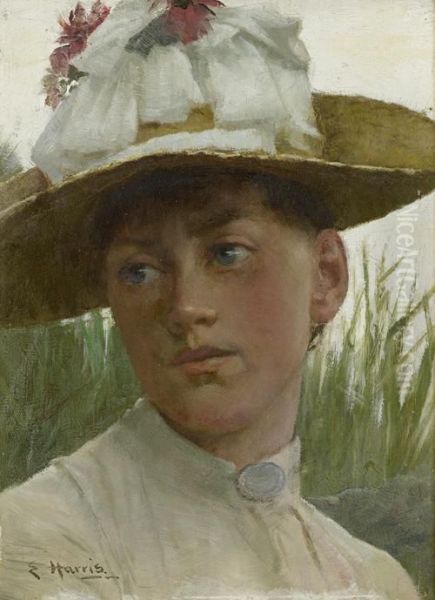Edwin Harris (1855-1906) stands as a notable figure within the landscape of late Victorian British art. Primarily associated with the Newlyn School of painters in Cornwall, Harris carved a niche for himself through his sensitive depictions of rural life, intimate interiors, and compelling portraits. Though perhaps overshadowed by some of his more famous contemporaries, his work offers a valuable window into the artistic currents of his time, particularly the pervasive influence of French Naturalism on British shores. His journey took him from the industrial heartland of Birmingham to the artistic hubs of Antwerp and Cornwall, reflecting a dedication to craft and a keen observation of the world around him.
Early Life and Artistic Formation in Birmingham
Born in Ladywood, Birmingham, in 1855, Edwin Harris grew up in a city rapidly transforming due to the Industrial Revolution. This environment, a crucible of innovation and social change, also fostered a burgeoning cultural scene. Harris received his initial education at the Old Edgbaston School before embarking on his artistic training. In 1869, at the relatively young age of fourteen, he enrolled at the prestigious Birmingham School of Art, a key institution in promoting art and design education outside London.
At the Birmingham School of Art, Harris studied under influential figures such as Charles Morgan, F.G. Jackson, and the headmaster Edward R. Taylor. Taylor, in particular, was a significant force, advocating for a curriculum that balanced fine art with design principles, reflecting the city's industrial base. Harris's time at the school laid the foundation for his technical skills and likely exposed him to the prevailing artistic debates of the era, including the growing interest in realism and the depiction of everyday life, moving away from the historical and mythological subjects favoured by earlier generations. He established his own studio just two years after starting his studies, indicating an early drive and confidence.
Continental Training and Influences

Like many ambitious British artists of his generation, Harris sought further training and exposure on the Continent. In 1880, accompanied by fellow Birmingham artist William John Wainwright, he travelled to Belgium to study at the Académie Royale des Beaux-Arts in Antwerp. He enrolled in the private atelier of Charles Verlat, a respected Belgian painter known for his historical scenes, animal paintings, and portraits. Studying under Verlat provided Harris with rigorous academic training, honing his draughtsmanship and understanding of composition.
However, the most profound influence Harris encountered during his time abroad, and arguably throughout his career, was the work of the French painter Jules Bastien-Lepage. Bastien-Lepage was a leading proponent of Rural Naturalism, a movement that focused on depicting peasant life and rural landscapes with objective truthfulness, often employing a muted palette and detailed observation. His technique, which frequently involved using square-tipped brushes to create a mosaic-like surface and painting en plein air (outdoors) to capture natural light, captivated many younger artists across Europe, including several who would later form the Newlyn School. Harris readily adopted these methods, which became hallmarks of his style.
The appeal of Naturalism, as championed by Bastien-Lepage and others like Jean-François Millet before him, lay in its perceived authenticity and its focus on the unvarnished realities of rural existence, a stark contrast to the often sentimentalised or overly academic art prevalent at the time. This commitment to truthful observation, combined with the technical innovations of painting outdoors with freer brushwork, resonated deeply with Harris and would guide his artistic direction upon his return to Britain.
The Call of the Coast: Brittany and Newlyn
Before settling definitively in Cornwall, Harris, like many artists drawn to rustic subject matter and picturesque locations, made brief visits to Brittany in France. He spent time in the towns of Dinan and Pont-Aven. Pont-Aven, in particular, was already becoming a magnet for artists, attracting figures ranging from American Impressionists to, slightly later, Paul Gauguin and his circle, who sought its 'primitive' charm and strong local traditions. These visits likely reinforced Harris's commitment to painting rural life and working directly from nature.
Around 1883, Harris moved to the small fishing village of Newlyn, near Penzance on the south coast of Cornwall. He was not alone; a growing number of artists, disillusioned with the London art establishment and inspired by French Naturalism and plein air painting, were drawn to Newlyn's dramatic coastal scenery, unique quality of light, and the perceived authenticity of the fishing community's way of life. Harris became one of the early and central figures in what would become known as the Newlyn School.

This burgeoning art colony included painters such as Stanhope Forbes, often considered the 'father' of the school, his wife Elizabeth Forbes (née Armstrong), Frank Bramley, Thomas Cooper Gotch, Norman Garstin, and Harris's childhood friend from Birmingham, Walter Langley. These artists shared a common goal: to depict the local people and their environment with honesty and empathy, often focusing on scenes of daily labour, domestic life, and the inherent drama of the sea. Harris would spend twelve formative years in this stimulating environment.
Life and Work in the Newlyn Colony
Edwin Harris quickly established himself as an integral part of the Newlyn artistic community. He initially lived at 'The Meadow', a property that became a welcoming haven and social centre for fellow artists. His presence contributed significantly to the collegial atmosphere of the colony, where artists often shared models, critiqued each other's work, and socialised together. His deep friendship with the landscape and figure painter William Albert Fitch, another Newlyn resident, exemplifies the close bonds formed within the group.
During his twelve years in Newlyn (roughly 1883-1895), Harris fully embraced the tenets of the school. He worked extensively en plein air, capturing the distinctive Cornish light and atmosphere in his landscapes and coastal scenes. He continued to employ the square brush technique learned from his admiration of Bastien-Lepage, building up his canvases with distinct, textured strokes. His subject matter revolved around the life he observed daily: the interiors of fishermen's cottages, portraits of local figures, quiet moments of domesticity, and the surrounding rural and coastal landscapes.
While some Newlyn painters, like Frank Bramley with his famous A Hopeless Dawn, focused on narrative drama and social commentary, Harris's work often possessed a quieter, more intimate charm. His paintings from this period are characterised by their careful composition, sensitivity to light and shadow, and empathetic portrayal of his subjects. He captured the textures of stone walls, worn furniture, and simple clothing with a fidelity born of close observation, creating works that were both realistic and deeply felt.
Artistic Style and Techniques
Edwin Harris's style is firmly rooted in the principles of late 19th-century Naturalism, heavily filtered through the specific influence of Jules Bastien-Lepage and the collective ethos of the Newlyn School. His commitment was to representational accuracy, seeking to depict the visible world without overt idealisation or sentimentality, although a gentle charm often pervades his work. This contrasted with the more radical experiments of Impressionism, which prioritised capturing fleeting moments of light and colour over detailed rendering and social narrative.

The plein air approach was fundamental. By painting outdoors, Harris could directly observe and translate the effects of natural light on his subjects, whether it was the silvery haze of a Cornish coastal day or the warm glow filtering through a cottage window. This practice lent an immediacy and freshness to his work. His use of the square brush technique contributed to a distinctive surface texture, avoiding overly smooth, academic finishes and adding a sense of solidity and structure to his forms.
His palette, typical of many Naturalist painters, tended towards muted tones – greys, ochres, browns, and greens – reflecting the often-sombre realities of rural life and the specific atmospheric conditions of Cornwall. However, he was adept at using light to create focal points and imbue his scenes with mood, often contrasting darker interiors with brightly lit doorways or windows. His figure painting, whether in portraits or genre scenes, showed a strong grasp of anatomy and character, capturing individuality without resorting to caricature. He worked proficiently in both oil and watercolour, bringing a similar sensitivity to detail and light to both media.
Notable Works and Themes
While a comprehensive catalogue of Harris's works is complex to assemble, certain paintings and recurring themes stand out. His Portrait of a Girl is often cited as a representative piece, likely showcasing his skill in capturing likeness and character with the refined yet robust technique typical of his Newlyn period. His genre scenes frequently depicted the interiors of Cornish cottages, focusing on the daily lives of the fishing community. These works often feature solitary figures or small groups engaged in quiet activities – mending nets, preparing food, reading, or simply resting.
These interior scenes allowed Harris to explore the interplay of light and shadow within confined spaces, highlighting the textures of simple furnishings and the resilience of the inhabitants. His landscapes captured the rugged beauty of the Cornish coast and countryside, often imbued with a sense of tranquillity. He painted the harbours, the fields surrounding Newlyn, and the distinctive architecture of the region. These works demonstrate his skill in rendering atmosphere and his deep appreciation for the natural environment.
Later in his career, particularly after returning to Birmingham, portraiture became a more significant part of his output. He undertook commissions and continued to paint portraits for his own interest, often focusing on family members and domestic subjects in his final years. His watercolours, though perhaps less numerous than his oils, display a similar attention to detail and atmospheric effect, showcasing his versatility across different media.
The Nelson Connection: Sketchbooks and Colonial Life

An intriguing aspect of the documentation surrounding Edwin Harris involves sketchbooks attributed to him, dating from the 1870s and 1880s, which record scenes from the Nelson region of New Zealand. This period overlaps with his formative years and time in Antwerp, making extensive activity in New Zealand during the entire span seem unlikely for Edwin Harris himself, though visits are possible, or the attribution might encompass materials from other family members or contacts. The user's source material links these sketchbooks directly to Edwin Harris, depicting colonial life with detailed observations.
The content described includes landscapes, featuring rivers, hills, farms, and trees, alongside depictions of the built environment such as houses, bridges, churches, and boats. Details like flying birds and horse-drawn carriages suggest a keen eye for the specifics of daily life in the colony. If indeed by Edwin Harris, these sketches would represent a fascinating, lesser-known dimension of his work, showing his observational skills applied to a vastly different environment from Cornwall or Birmingham. They would serve as valuable historical documents of early colonial Nelson as well as artistic exercises.
The mention of other Harris family connections in Nelson, including sisters possibly involved with an Alan James Harris who experienced mental health issues, adds a layer of personal complexity to this potential New Zealand link. Whether these sketches were made during a visit, or collected by him, or belong to another relative, they form part of the narrative associated with his name and collections, reflecting the global reach of British families and potentially artists during the Victorian era. Further research might clarify the precise nature and timing of this connection.
Return to Birmingham and Later Career
In 1895, after twelve years immersed in the unique artistic environment of Newlyn, Edwin Harris made the decision to leave Cornwall and return to his native Birmingham. The reasons for this move may have been varied, potentially including personal circumstances, shifting artistic priorities, or the changing dynamics of the Newlyn colony itself, which was evolving as the initial pioneering phase passed.
Back in Birmingham, Harris shifted his professional focus increasingly towards portraiture. This was a common trajectory for established artists, as portrait commissions offered a more reliable source of income than speculative genre or landscape painting. He continued to exhibit his work, notably at the Royal Birmingham Society of Artists (RBSA), an institution he had long been associated with. His connection was solidified in 1888 when he was elected a Member of the RBSA, a significant local honour recognizing his standing in the artistic community.
His later works also saw a turn towards more intimate, domestic subjects, often featuring his own family. This focus might reflect a natural evolution in his interests, or perhaps a response to personal events, particularly the earlier loss of his wife. He also engaged in teaching, passing on his skills and experience to a new generation of artists in Birmingham, contributing to the city's ongoing artistic vitality. His career, therefore, came full circle, returning to the city where his artistic journey began.
Personal Life: Connections and Tragedy
Edwin Harris's personal life contained elements of both advantageous connection and profound sadness. He married Ellen (Nellie) Sadler Tirbutt in 1882. His wife was notably the niece of a prominent Birmingham art dealer, a connection that likely provided Harris with valuable access to the art market and potential patrons, particularly in his early career and later return to the city. This link highlights the often-important role of social and familial networks in the careers of Victorian artists.
The couple had a son, born in 1884. However, their family life was struck by tragedy just three years later when Nellie died in 1887. Losing his wife relatively early in their marriage must have been a devastating blow for Harris, impacting him personally and perhaps influencing the emotional tenor of his subsequent work and life choices, including his eventual return to Birmingham and the later focus on domestic themes.
The anecdotes surrounding his family, including the potential romantic involvements of his sisters in Nelson and the story of Alan James Harris, paint a picture of the broader familial and social context within which Harris lived. These details, while peripheral to his core artistic output, remind us that artists' lives are interwoven with the complex tapestry of human relationships, successes, and sorrows that shape their experiences and, subtly or overtly, inform their creative expression.
Legacy and Historical Evaluation
Edwin Harris occupies a respected, if not leading, position within the history of late Victorian British art. His primary legacy lies in his contribution to the Newlyn School, where he was an important early member and a significant presence for over a decade. His work exemplifies the core tenets of the school: a commitment to truthful observation, plein air painting, and the depiction of everyday rural and coastal life, heavily influenced by French Naturalism, particularly Bastien-Lepage.
Compared to the 'stars' of the Newlyn School like Stanhope Forbes or Frank Bramley, whose works often tackled larger social narratives or more dramatic compositions, Harris's contribution is perhaps characterised by a quieter intimacy and charm. His focus on cottage interiors and gentle landscapes provides a valuable counterpoint, showcasing the breadth of subject matter explored within the colony. He stands alongside figures like Walter Langley, who also focused on the pathos and dignity of the fishing community, though perhaps with a greater emphasis on watercolour.
His technical skill, particularly his handling of light and his adoption of the square brush technique, was considerable. His work found recognition during his lifetime through exhibitions at major venues like the Royal Academy and his election to the RBSA. Today, his paintings are held in public collections, including the Penlee House Gallery & Museum in Penzance (which specialises in the Newlyn School) and the Royal Albert Memorial Museum in Exeter, ensuring his work remains accessible. While not an innovator on the scale of some contemporaries like George Clausen or Henry Herbert La Thangue, who pushed Naturalism in different directions, Harris remains a significant representative of the movement and a key chronicler of the Newlyn artistic phenomenon.
Conclusion
Edwin Harris's life and career trace a path familiar to many British artists of his generation: solid provincial training, transformative exposure to Continental influences, immersion in a supportive and stimulating art colony, and a later career balancing personal expression with the demands of the art market. From the industrial energy of Birmingham to the coastal light of Cornwall, Harris dedicated himself to capturing the world around him with honesty, sensitivity, and considerable technical skill.
Strongly influenced by French Naturalism and a core member of the influential Newlyn School, he excelled in depicting the quiet dignity of rural life, the atmospheric beauty of the landscape, and the nuanced character of his portrait subjects. Though marked by personal tragedy, his career demonstrates a consistent dedication to his craft. Edwin Harris remains an important figure for understanding the development of British realism in the late 19th century and the unique artistic flowering that occurred in the fishing villages of Cornwall. His paintings continue to offer a gentle yet truthful glimpse into a bygone era.